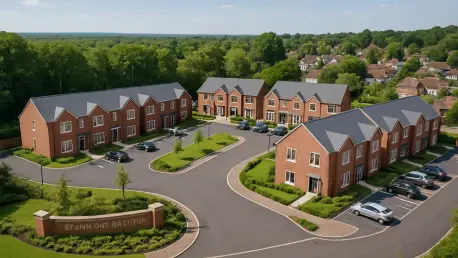In the dynamic landscape of London’s property market, a staggering £180 million Gross Development Value (GDV) transaction has caught the attention of industry watchers, highlighting the growing investment in suburban areas. Gracie Group, a luxury property developer based in London, has acquired the Stanmore Gardens project, a residential-led development in the heart of Stanmore town center, northwest London. This deal, facilitated by real estate advisor CBRE and purchased from Notting Hill Genesis, underscores a growing trend of investment in well-connected suburban areas. With London’s urban core nearing saturation, such acquisitions highlight the shifting focus toward high-growth zones that balance accessibility with quality of life.
The purpose of this analysis is to dissect the implications of this acquisition for the northwest London property market, exploring why Stanmore is becoming a focal point for developers. This examination will provide stakeholders with critical insights into current trends, future projections, and strategic opportunities in suburban development. By delving into the specifics of the Stanmore Gardens site and Gracie Group’s broader portfolio, valued at £550 million, this analysis aims to illuminate the forces driving investment in areas outside traditional central hubs.
Stanmore, with its blend of suburban charm and urban connectivity, serves as a case study for understanding where the London property market is headed. The following sections will analyze market patterns, assess data surrounding suburban growth, and offer projections on how developments like Stanmore Gardens could redefine residential and mixed-use projects. This is not just about one deal; it’s about recognizing a pivotal shift in how developers are approaching housing demands in a sprawling metropolis.
Market Trends and Data Driving Suburban Investment
Stanmore’s Emergence as a Property Hotspot
Northwest London, particularly Stanmore, has witnessed a remarkable transformation over recent years, evolving from a quiet residential area into a sought-after destination for property investment. Data from local planning authorities, such as the Harrow Local Plan, indicates a deliberate push toward sustainable development in town centers, with Stanmore benefiting from policies that encourage high-quality residential growth. This suburb’s appeal lies in its proximity to central London, coupled with an abundance of green spaces like Stanmore Country Park and Bentley Priory Open Space, making it a magnet for families and professionals alike.
Transport connectivity further fuels Stanmore’s rise, with the Jubilee Line at Stanmore Underground Station offering direct access to key London hubs like Bond Street in just 30 minutes. Such infrastructure has positioned the area as a viable alternative to central zones, where property prices often exclude many buyers. Market reports suggest that suburban areas with strong transport links have seen a 15-20% increase in developer interest over the past few years, a trend likely to continue as remote working and hybrid lifestyles drive demand for spacious, accessible living environments.
This shift is not isolated to Stanmore but reflects a broader pattern across London, where developers are targeting suburbs to meet housing shortages without compromising on lifestyle amenities. The Stanmore Gardens site, spanning 2.58 acres and including key parcels like Anmer Lodge and Stanmore car park, epitomizes this opportunity. Its strategic placement just north of Stanmore Broadway aligns with market needs for well-located, design-focused projects that cater to a growing demographic seeking suburban tranquility with urban access.
Economic and Demographic Drivers of Growth
Economic indicators point to sustained growth in northwest London’s property sector, driven by demographic shifts and evolving buyer preferences. Families and young professionals are increasingly drawn to areas like Stanmore due to top-tier schools and a lower cost of living compared to central districts. Statistical trends show a steady rise in population density in Harrow, with projections estimating a continued uptick through 2027, necessitating new housing stock to accommodate this influx.
Developer confidence in such regions is bolstered by favorable economic conditions, including relatively stable interest rates and government incentives for residential projects. Gracie Group’s acquisition of Stanmore Gardens, with pre-existing planning consent for residential and retail uses, reflects a calculated move to capitalize on these conditions. The alignment with local authority goals, evidenced by pre-application discussions with the London Borough of Harrow and the Greater London Authority, minimizes regulatory risks and enhances the project’s viability in a competitive market.
Moreover, the demand for mixed-use developments is reshaping investment strategies, as buyers and tenants prioritize spaces that integrate living, working, and leisure. This trend is particularly pronounced in suburban markets, where community-centric designs can differentiate a project. For Gracie Group, leveraging these economic and demographic drivers could position Stanmore Gardens as a benchmark for future developments, provided execution aligns with market expectations around sustainability and quality.
Competitive Landscape and Developer Strategies
The competitive landscape in northwest London reveals a crowded field of developers vying for prime suburban sites, yet few match the scale and ambition of Gracie Group’s portfolio. With a £550 million collection of residential and mixed-use projects across London and the Southeast, the company stands out for its focus on high-growth areas. The acquisition of Stanmore Gardens adds a significant asset to this portfolio, signaling an aggressive strategy to dominate emerging markets where connectivity and community value intersect.
Analysis of competitor activity in the region shows smaller-scale projects dominating recent years, often lacking the transformative potential of larger sites like Stanmore Gardens. This gap in the market offers Gracie Group a chance to set a new standard, particularly by emphasizing sustainable building practices and innovative design. Industry patterns suggest that developers who prioritize green infrastructure and energy efficiency are gaining favor among buyers, a factor likely influencing Gracie Group’s approach to this 2.58-acre freehold site.
Challenges remain, however, as community resistance to overdevelopment and concerns about traffic congestion could impact project timelines. Market data indicates that successful developers in similar suburban zones often invest in early stakeholder engagement to mitigate such risks. For Gracie Group, navigating this competitive terrain will require balancing profitability with local expectations, a dynamic that could shape the broader northwest London market as more players enter the fray.
Future Projections for Northwest London’s Property Sector
Sustainability as a Market Differentiator
Looking ahead, sustainability is poised to become a defining factor in London’s property market, particularly in suburban developments where community impact is under scrutiny. Projections suggest that by 2027, regulatory frameworks will tighten around environmental standards, pushing developers to adopt energy-efficient designs and green spaces as standard features. For a project like Stanmore Gardens, this trend presents an opportunity to lead the market by integrating eco-friendly elements that resonate with modern buyer values.
Industry forecasts also highlight the growing importance of technology in construction, with modular building techniques and smart home systems expected to streamline costs and enhance appeal. Developers who adopt these innovations early could gain a competitive edge, especially in areas like Stanmore where differentiation is key. Gracie Group’s stated commitment to design-focused projects suggests readiness to embrace such advancements, potentially setting a precedent for how suburban sites are reimagined over the coming years.
The risk of market saturation looms, however, as more developers target northwest London. Projections indicate a potential oversupply of residential units if demand does not keep pace with construction. To counter this, mixed-use schemes that incorporate retail and community amenities are likely to remain in favor, ensuring projects like Stanmore Gardens cater to diverse needs while maintaining economic viability in an evolving landscape.
Connectivity and Infrastructure Investments
Connectivity will continue to drive property values in suburbs like Stanmore, with planned infrastructure upgrades across northwest London expected to further boost accessibility. Transport authorities have outlined enhancements to the Jubilee Line and regional road networks, including the M1 and M25 corridors, which directly benefit the Stanmore Gardens site. Market analysis predicts a 10-15% uplift in property prices in areas with improved transport links over the next few years, underscoring the site’s long-term investment potential.
Beyond transport, local government plans for community infrastructure—such as schools and recreational facilities—will play a critical role in shaping buyer interest. Stanmore’s reputation for educational excellence and green spaces already provides a strong foundation, but sustained investment in these areas could amplify demand. Developers who align projects with such initiatives are likely to see greater market acceptance, a factor Gracie Group must consider as plans for Stanmore Gardens progress.
Economic uncertainties, including potential interest rate fluctuations, could temper growth projections if borrowing costs rise. Nevertheless, the underlying demand for well-connected suburban housing suggests resilience in markets like Stanmore. Forward-looking data points to a steady influx of buyers seeking alternatives to central London, positioning sites with strong infrastructure ties as safe bets for sustained developer interest.
Community-Centric Development as a Growth Lever
A pivotal trend shaping future projections is the emphasis on community-centric development, where projects are designed to enhance local vitality rather than merely add housing stock. Market studies reveal that developments incorporating public spaces, retail hubs, and cultural amenities often outperform purely residential schemes in terms of long-term value. For Stanmore Gardens, this could mean redefining the town center with a mixed-use approach that benefits both residents and businesses.
Community engagement will be equally critical, as opposition to large-scale projects can derail timelines and inflate costs. Projections based on recent suburban developments suggest that transparent communication and inclusive planning processes significantly reduce resistance. Gracie Group’s ability to navigate these social dynamics could influence not only the success of this project but also set a model for future endeavors in northwest London.
Ultimately, the trajectory of the property market in this region hinges on balancing growth with preservation of suburban identity. Forecasts indicate that developers prioritizing this balance will capture a larger share of buyer interest, particularly as London’s housing crisis pushes more families outward. Stanmore Gardens, with its prime location and planning support, stands at the forefront of this movement, potentially heralding a new era of thoughtful suburban expansion.
Reflecting on Market Insights and Strategic Pathways
Looking back, the analysis of Gracie Group’s £180 million acquisition of Stanmore Gardens reveals a nuanced picture of northwest London’s property market, marked by robust growth in suburban areas driven by connectivity and demographic shifts. The examination of market trends and future projections underscores Stanmore’s emergence as a development hotspot, bolstered by economic drivers and a supportive planning framework. Challenges such as community concerns and competitive pressures emerge as critical considerations that shape the strategic landscape for developers in the region.
For stakeholders, the key takeaway is the importance of aligning projects with sustainability goals and community needs to ensure long-term success. A recommended pathway involves prioritizing early engagement with local authorities and residents to build trust and address potential opposition. Additionally, integrating innovative design and green infrastructure stands out as a way to differentiate projects in a crowded market, offering a blueprint for navigating future regulatory and buyer expectations.
As a next step, developers and investors are encouraged to explore similar high-growth suburban zones, leveraging data on transport links and demographic trends to identify untapped opportunities. Partnerships with local councils could further streamline planning processes, while a focus on mixed-use developments promises to meet diverse market demands. These strategies, inspired by the Stanmore Gardens case, provide actionable guidance for capitalizing on the evolving dynamics of London’s property sector, ensuring that growth and community value go hand in hand.









